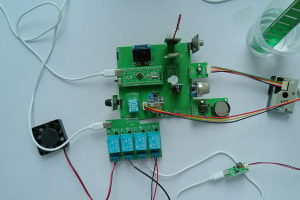设计说明书
总字数:27000+
摘要
随着人们对室内生活质量关注度的不断提升,室内空气质量的精准监测与及时调控对保障人体健康、提升居住舒适度具有重要意义。传统的室内空气管理多依赖人工观察和手动操作,不仅存在监测滞后、调控不及时的问题,还难以全面掌握多项空气参数的变化,无法满足现代化生活对安全、健康室内环境的需求。
基于 STM32F103C8T6 单片机的室内空气监测系统,整合了 MS1100 甲醛检测模块、GP2Y10 PM2.5 模块、YS-17 火焰传感器、MQ-2 烟雾传感器、MQ-5 可燃气体传感器、DHT11 温湿度传感器、YW-J 液位检测模块、DS1302 时钟模块、D203S 人体热释电感应模块、OLED 显示屏、3 个独立按键、SU-03T 语音识别模块、ESP8266WiFi 模块及执行设备(风扇、水泵、加湿器、消毒灯、声光报警器等),实现了室内空气的全方位监测与智能调控。系统核心功能包括:通过 MS1100 和 GP2Y10 分别检测甲醛和 PM2.5 浓度,超标时启动声光报警并开启风扇;借助 YS-17 检测明火,触发时控制水泵灭火并报警;通过 MQ-2 和 MQ-5 监测烟雾与可燃气体浓度,超标时启动风扇并报警;利用 DHT11 监测温湿度,温度过高时开启风扇并报警,湿度过低时启动加湿直至达到最大值;通过 YW-J 检测加湿器液位,缺水时停止加湿并提醒;依托 DS1302 获取时间,支持定时紫外线消毒设置;通过 D203S 感应人体,自动模式下有人时关闭消毒灯;支持通过按键设置各参数阈值、定时消毒时间、切换模式及控制设备;通过 OLED 显示各项数据与设置;借助 ESP8266WiFi 将数据上传至 APP,支持 APP 远程控制与参数修改;通过 SU-03T 语音识别模块实现语音助手功能,支持语音指令控制设备并播报状态。
该系统的实现,有效提升了室内空气监测与调控的自动化、智能化水平,全面保障了室内环境的安全性与健康性,为打造舒适、安全的室内生活空间提供了高效、可靠的解决方案,同时为同类室内环境监测设备的研发提供了参考,具有较高的实际应用价值。
关键词:STM32F103C8T6;室内空气;监测系统;传感器;智能调控;WiFi 通信
ABSTRACT
With the increasing attention paid to indoor living quality, precise monitoring and timely regulation of indoor air quality are of great significance for ensuring human health and improving living comfort. Traditional indoor air management mostly relies on manual observation and manual operation, which not only has problems of monitoring lag and untimely regulation, but also is difficult to fully grasp the changes of multiple air parameters, failing to meet the needs of modern life for a safe and healthy indoor environment.
The indoor air monitoring system based on the STM32F103C8T6 microcontroller integrates MS1100 formaldehyde detection module, GP2Y10 PM2.5 module, YS-17 flame sensor, MQ-2 smoke sensor, MQ-5 combustible gas sensor, DHT11 temperature and humidity sensor, YW-J liquid level detection module, DS1302 clock module, D203S human pyroelectric sensor, OLED display, 3 independent buttons, SU-03T voice recognition module, ESP8266WiFi module and executive devices (fan, water pump, humidifier, disinfection lamp, acousto-optic alarm, etc.), realizing all-round monitoring and intelligent regulation of indoor air. The core functions of the system include: detecting formaldehyde and PM2.5 concentrations through MS1100 and GP2Y10 respectively, activating acousto-optic alarm and turning on the fan when exceeding the standard; detecting open fire with YS-17, controlling the water pump to put out the fire and alarm when triggered; monitoring smoke and combustible gas concentrations through MQ-2 and MQ-5, starting the fan and alarming when exceeding the standard; monitoring temperature and humidity with DHT11, turning on the fan and alarming when the temperature is too high, and starting humidification when the humidity is too low until reaching the maximum value; detecting the liquid level of the humidifier through YW-J, stopping humidification and reminding when water is insufficient; obtaining time by virtue of DS1302, supporting the setting of timed ultraviolet disinfection; sensing human body through D203S, turning off the disinfection lamp when there is someone in automatic mode; supporting the setting of various parameter thresholds, timed disinfection time, mode switching and equipment control through buttons; displaying various data and settings through OLED; uploading data to APP via ESP8266WiFi, supporting APP remote control and parameter modification; realizing voice assistant function through SU-03T voice recognition module, supporting voice command to control equipment and broadcast status.
The implementation of this system effectively improves the automation and intelligence level of indoor air monitoring and regulation, comprehensively ensures the safety and health of the indoor environment, provides an efficient and reliable solution for creating a comfortable and safe indoor living space, and also offers a reference for the research and development of similar indoor environment monitoring equipment, with high practical application value.
Keywords: STM32F103C8T6; Indoor air; Monitoring system; Sensor; Intelligent regulation; WiFi communication
目录
第 1 章 绪论
1.1 研究的目的及意义
1.2 国内外发展情况
1.3 本文主要研究内容
第2章 设计思路与方案论证
2.1 主要元器件选择
2.1.1 主控芯片选择
2.1.2 甲醛检测模块选择
2.1.3 PM2.5 模块选择
2.1.4 火焰传感器选择
2.1.5 烟雾传感器选择
2.1.6 可燃气体传感器选择
2.1.7 温湿度传感器选择
2.1.8 液位检测模块选择
2.1.9 时钟模块选择
2.1.10 人体热释电感应模块选择
2.1.11 显示模块选择
2.1.12 按键模块选择
2.1.13 WiFi 模块选择
2.2整体设计方案
第 3 章 硬件设计
3.1 主控电路模块
3.2 甲醛检测模块电路
3.3 PM2.5 模块电路
3.4 火焰传感器电路
3.5 烟雾传感器电路
3.6 可燃气体传感器电路
3.7 温湿度传感器电路
3.8 液位检测模块电路
3.9 时钟模块电路
3.10 人体热释电感应模块电路
3.11 显示模块电路
3.12 按键模块电路
3.13 WiFi 模块电路
3.14 语音识别模块电路
3.15 执行设备驱动电路
第4章 系统程序设计
4.1 编程软件介绍
4.2 系统主流程设计
4.3 独立按键
4.4 OLED显示流程设计
4.5 温湿度检测模块子流程
4.6 PM2.5检测模块子流程设计
4.7 时钟模块子流程设计
4.8 WiFi模块子流程设计
第 5 章 实物测试
5.1 整体实物测试
5.2 甲醛检测模块功能测试
5.3 PM2.5 模块功能测试
5.4 火焰传感器功能测试
5.5 烟雾传感器功能测试
5.6 可燃气体传感器功能测试
5.7 温湿度传感器功能测试
5.8 液位检测模块功能测试
5.9 人体热释电感应模块功能测试
5.10 WiFi 模块功能测试
5.11 语音识别模块功能测试
5.13 按键设置与显示功能测试
第 6 章 总结与展望
6.1 总结
6.2 展望
致谢
参考文献
附录
附录一:原理图
附录二:PCB
附录三:主程序
购买后可查看具体内容!

